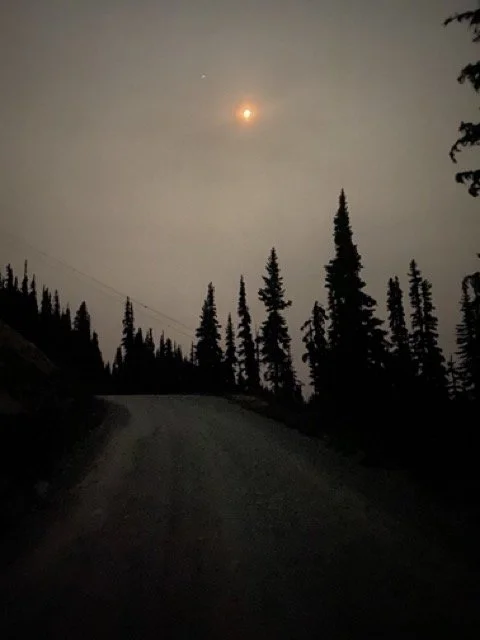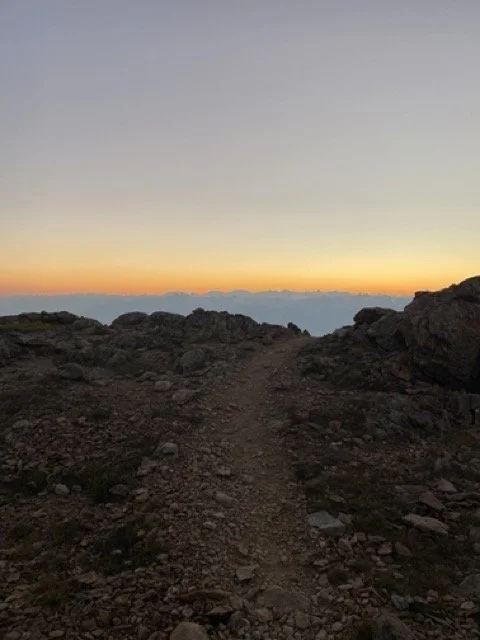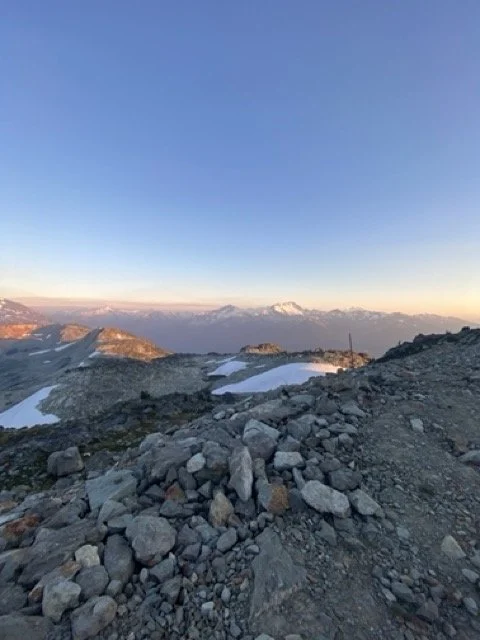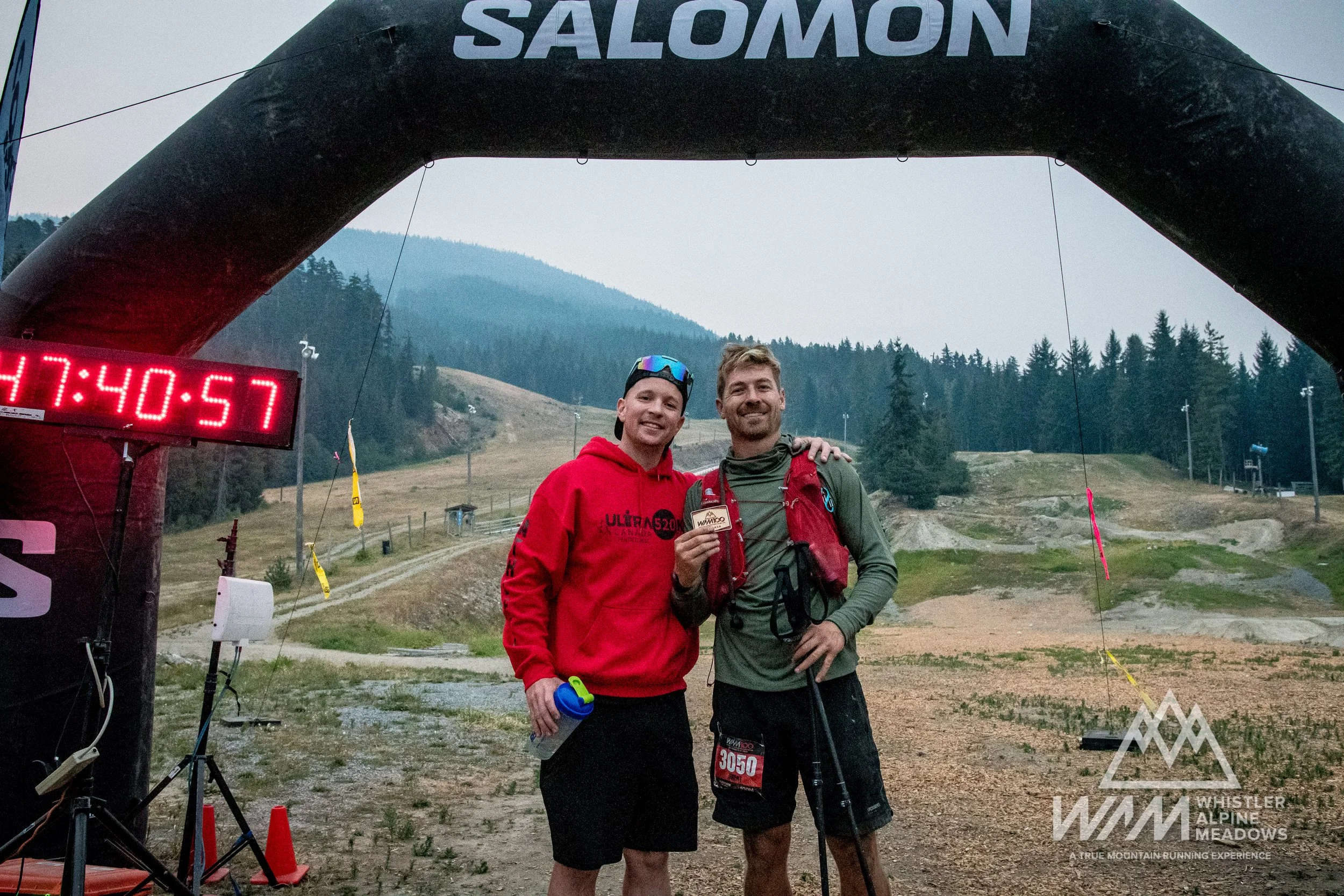48 Hours in Flow
I needed to look only at where I was taking my next step and only my next step. That was my clear goal.
If I looked beyond my next step, I'd either be overwhelmed at the size of the mountain I needed to climb, or I'd enter a terrifying hallucination. Trees became mythic and prehistoric creatures, large boulders appeared as uber woke folk, those who love to virtue signal and were plotting to cancel me. To keep my psyche in a state of order and out of chaos, my first key was remaining focused on the goal of the next step illumined by my headlamp.
I was 30 hours into my first 100 mile ultra race, I had run over 75 miles and gained 20,000 ft of elevation and the job was not close to being done. I was as scared as I could be as I trekked down Whistler in the dead of night, for hours on end, by myself and with one bad ankle already. If I looked away from my next step and got anymore paranoid from those hallucinations, I feared bears might intuit I was a weakened animal they could prey on. The stakes were high.
With these high consequences and fear at the tip of my psyche, griping my consciousness like a choke hold, there was not a minute during those 48 hours that I was even slightly tired. Time was ticking for the 48 hours cutoff and the real truth is, I didn't want to let my clients down; they knew I was taking on this challenge and I felt like I was representing for them and also for flow science. In a society where too often our consciousness oscillates between anxiety or boredom, I intended to display how sustained flow was possible when we enter intelligently designed environments; and I hoped how this may model part of the solution to solving the work and mental health crisis we are all in.
Beyond the clear goal of concentrating on only my next step, my second key to flow was ensuring that my action was leading towards a pink course marker flag on the ground or pink ribbon hanging from a tree. Course director, and Ultra Legend Gary Robbins was well known for good marker placement, but even still within my first 6 hours I went 3 miles off course and had to back track - that's right, I was now the only person running a 103 mile race. This felt devastating at the time, but a volunteer later on reminded me it was better to make this mistake early on in the race when I still had energy, and there was still time, to make up for the loss. Ok, challenge accepted, and from that moment on I didn't let a marker go past me without acknowledging it. I suspect that was at least 10,000 markers. Soon enough, the repeated feedback from those pink flags allowed me to drop my conscious analytical mind and move from my unconscious - whats known as the performance system of information processing. As long as I was passing a pink marker I knew I was moving in the right direction. Thinking Brent didn't need to be in the picture. In fact, it was much better if Brent was not there. In time, each flag felt like it was there just for me. There was a level of sentimental feelings and joy with each one, as if it was a signalling a welcoming home party for me. And eventually, it felt like I was each flag that passed me by. The immediate feedback from the flags, a well known flow trigger, had taken effect; I was now superman.
In Lao Tzu's Tao Te Ching, which means "the way," he wrote about "wu-wei," a state of action through non-action, what he described as the highest and most pure form of action. He described wu-wei as a state where a great athlete merges with their sport, the poet with the words on the page, and a dancer with the dance. Think of Michael Jordan in Game 1 of the 1992 Finals, where he effortlessly hit six 3's in the first half and his instinctual response was just to shrug and to put up his hands, as if to say, this is magic and not even I can explain it. Mihalyi Csikszentmihalyi, the Godfather of flow theory, termed this phenomenon as "action and awareness merging." Whatever you want to call it, I was right there; I had arrived into flow. All of the elements of STER, an acronym used to describe flow were present: Selflessness, Timelessness, Effortlessness, and Richness in the experience.
But before superman entered the picture, about 15 miles, 10,000 ft and 10 hours prior, Brent was about to give up. I almost waved the white flag. I almost said no mas.
My body was a complete wreck after hiking 24 hours straight and my friend Stephen, who I was with the whole time and had planned to cross the finish line with, had just waved his own white flag with a knee injury. Now Stevo is a complete nut case. Although he is slightly reformed as a new father, he had done multiple Ironman before (running in his fireman suit in them too) and he was the very reason why I ended up in this damn race in the first place. If he was quitting I thought I probably could too. I also knew how helpful it was having him by my side, serving as another feedback mechanism to keep me locked into the run and also someone who was modeling the way forward. The group flow state we had gotten into together in our training brought my fitness to another level as well as our friendship and not to mention confidence. I doubted I could go on alone. So when I arrived at the Aid station where I had I left him and they told me that he was taken down in a car, my mind had a momentary lapse, and it tried to insinuate this gave me a window of opportunity to also quit without shame. And so I told the aid station volunteers that I thought I was done too. And then one of the guys, an experienced Ultra athlete, smiled at me and told me something that helped me regain order at that moment of chaos.
He simply said, "this is when your body surprises you...[with what it's capable of]" is how I took it.
Armed with that reality bending thought, one that open up a new world of possibility, I carried the fuck on. Third lesson to flow, allow for a beginners mind, you don't know how this may end. Believe that there are further reaches of your human potential.
Little did I know, 5 miles later and a couple thousand more feet of elevation, my left ankle would start its own steady climb towards excruciating pain. I don't recall rolling it, but every time I flexed or extended my left foot there was serious sharp pain - and this was not ideal given that every step, especially when moving up or down in elevation, required me to flex and extend the ankle - and I had a lot of steps still ahead of me. I don't think this is what he meant by my body surprising me, but regardless I carried on to the next step - now heavily supporting my left ankle with my hiking poles. With every big step up now, I would first place my left foot up and then literally pull myself up with the poles. And then with every step down, I would first secure my position with the poles and lighten the load on the left foot. I didn't think about needing to do this for another 30 miles, just that next damn step. This is the fourth lesson to flow, find your challenge and skill balance - break the challenges into smaller more manageable steps in my case, and use support to boost your skill level. At one point I even resorted to ripping down a pink marker ribbon and wrapped my ankle with it. I made sure it was not a necessary one for others behind me, albeit I was about the last of the line already by this point.
This is what the 100 mile race was all about: staying focused on the next step, keep moving at any pace possible, and continuousproblem solving.
It was also about breaking the limits of what I thought was possible - and that was about to happen in a real way. When you look up from the base to the peak of a mountain such as Whistler or Blackcomb it's daunting; every time I did look up to the peaks I never believed it was possible to trek them within the given time period. Looking at the destination completely jacked me up! Humbled, I'd again return to looking down at the next step, and eventually, beyond my comprehension, I would arrive at the peak and look down amazed by the ground I had covered. I suppose this is true with all goals in life, whether its intimidation or straight up hallucinations - or what psychologists call cognitive distortions - its always better to stay in the present moment and take on just the next step.
As I summited Whistler for the second time in 36 hours, with my bad ankle, something fundamentally changed inside me. The previous hours of the climb were know longer in the woods and instead in the blistering sun and up a very technical rocky terrain.The flys were terrorists. But now I had my 3.5 legs and made it up. And then, I started to cry right as I got to the top of Whistler. It was a fucking battle to make it up with one foot and in that heat, so I welcomed the emotional release. There was another Aid station at the top, so maybe I also knew I was "safe" again, that I could possibly ask for a ride down, and therefore, that I could let my consciousness shift from just the next step to the bigger picture of all that was unfolding. Like all the aid stations, they sat me down, filled up my hydration packs, gave me food - including the long awaited pancakes - and I even managed to get a sponge with water to cool my body down. Maybe the tears were for the pancakes alone, but I doubt it; it felt like that feeling of relief those tears gave me was why I signed up for the race in the first place. That massive struggle of my second Whistler ascent produced a huge release of serotonin and I felt at the top of the world as I stood at the top of Whistler. And I say something fundamentally shifted in me because it was at my most humbled moment that I felt the greatest joy. Life humbles us all and this year was no exception for me so I welcomed this insight - accept humility as it brings you your greatest joys. In Buddhism it's taught that our self grasping, that is, our attachment to a sense of an individual self that we ought to protect, uplift and privilege over others is the root cause of our suffering, which is why many meditations focus on ways to crush our ego. By crushing our ego, and by putting ourselves below others, joy can flow into our heart. Similar to how all rivers flow to the ocean because it puts itself below them; it is our humility that gives us our power.
But the job wasn't done.
Alright, fuck it! I figured I was going to keep going as long as I could take one more step. At this point I was no longer running and most people started to pass me by, but I knew I could take one more small and slow step so I committed to that. I wasn't going to quit now. This catches our story back up to hallucinating in the woods 30 hours in, albeit skipping my emergency poo on the peak of Whistler with no trees or toilet around, just shattered rocks and openness for all to see. Let's skip the details of pooing in flow state for now and return back to the bottom of Blackcomb, 42 hours in and with just one final, what I thought, easy climb up some marginal height of Blackcomb before victory at last; or so I thought so.
As I sat at the bottom of Blackcomb, in what was my second last aid station, the volunteer staff seemed very up beat and optimistic about my ability to finish the run before the cut off. They were feeding me quesadillas, massaging my leg, and teaching me how to roll out my calf with the pole should my ankle start to cease up on me. I had to stop their chatter and say I better get to it; if I learned anything from this run so far it was that whatever people said was ahead of me it was 10 x harder and that problems were bound to happen. At this point I turned my phone back on after going dark mode for the last 20 hours. I called Stevo who picked up the phone in a frenzy, "HOGIE!" he said. "Are you ok? It said you didn't finish hours ago and I was just about to call your family and search and rescue." I responded, "Stevo, I have not stoped since we split brother and I'm on my final ascent up Blackcomb right now and should be able to make the cut off." To hear his amazement, what he later told me were tears of joy and pride, really made it a special moment for us. We had agreed to complete the race together and although injury got him, he told me he would make it to the finish line to watch me cross. I thought this was kind of him given it would be 6 am and I figured he was beyond tired himself - little did I know he was drinking since we split, again, Stevo is still a nutcase. But again, the ascent started off as a breeze, a very steep stair climb up an ancient forrest which had periodic quotes by John Muir and others on the power of being in nature. One of them read, "Into the forest I go to loose my mind and find my soul." It felt like a joy to be that close to the end, enjoying nature and with victory so close. I would soon return to civilization and to being a human.
As I climbed out of the forrest, I was directed to my next direction by volunteers who were cheering with their typical cow bells that would always give me a great sense of motivation. Another lesson, cow bells are magic. But when I climbed to the next location, I got lost, again. I didn't know If I was to go left or right down a cat track. I went right. Left appeared to be the way I had just came. But there were very few pink flags and 15 minutes down the trail I panicked. I started yelling to see if anyone would hear me. No one did. This made my anxiety worse. I ran back up to the crossroad to make sure I took the correct turn. I did but I had now lost at least 30 more minutes.
By the time I reached the final aid station I was no longer welcomed by optimistic and congratulatory faces. As they sat me down, I felt uneasy as they were so serious. That's when a lady came up to me and said, "ok, you see that light way up there?" She pointed to what seemed like 90 degrees towards the darkened heavens. "That's where you need to go and fast - you have just 4 hours." Another man then approached me, more concerned than the rest, and he made sure to tell me it was the most technically challenging, as in all big and loose rocks, terrain of the whole course but that if I could complete said loop in a good time I should be able to make the 48 hour race cut off. He started to try to give me directions of what was to come but it was incredibly confusing, and he was already on my nerves, so I cut him off half way and just said I'd follow the pink flags. Damn, I had come this far and I might not even make it in time. This was typical of the 48 roller coaster ride which is WAM. On I went, towards a faint light 90 degrees towards the dark sky. There was an orange moon from the forrest fires that I admired for a minute; just enough to realize how my recently acquired bloody nose was likely caused by the smokey air. Then I put my head down again and, with the batteries replaced in my headlamp, I followed the golden rule of being present with the next step - and pull up with my poles - at a time. It was final destination.
I gave it everything I fucking had and I mean everything.
There are very few challenges in our modern life that have required me to give it absolutely everything I had for an entire day, let alone two, but WAM100 definitely did that for me. I needed every second of the day. I could not even sleep and waste a second. Before his death, Csikszentmihalyi once wrote about how the most challenging moments in our lives, those that stretch our skills and require all of our attention, in turn end up being the most meaningful. He seemed to cringe at the thought of relaxing vacations on the beach; these were not paths to self actualization. I thought about this as I trekked up the final loose rocks, now rolling my bad ankle and wincing with every other step. I had previously been scared to walk in the dark in the woods and I also feared bears immensely; but now I felt like I was the one who ought to be feared.
As I came down the rocky loop I met a volunteer who offered me an Advil and I used her sports tape to wrap up my ankle. We spoke about how she lived in Squamish and the joys of being in nature and I told her how I was also considering moving there. It was a nice, ordinary human conversation during a completely uncivilized moment in my life. Or perhaps, it can be looked at the other way around, and that my time in the woods was actually helping me to become civilized and returning to my human nature, whereas returning to business as usual in the city was becoming non-human. As flow is a state dependent on exercising our autonomy, there is some truth to this. In FLOW: the psychology of Optimal Experience, Csikzsentmihalyi wrote about the need to free ourself from the tyrants of societal pressures of conformity as well as our biology which seeks comfort. Both of these tyrants were overpowered when I began this race and I had a renewed commitment to never let them rule my life again.
I crossed the finish line at 47 hours and 37 minutes where Gary Robbins handed me my WAM100 Belt Buckle. I didn't have much to say to him or Stephan. My moment was when I was all alone with tears coming down my face at the top of Whistler in the thick of it all. That was when I really existed, because I didn't exist at all - only the next step towards my goal did. That was when I was in flow state.
Life has a miraculous way of presenting its own custom problems to us that we need to solve. And it appears as though life will continue to give us the same problem but in different forms until we have finally solved it. With most problems, the starting point seems to be looking within ourselves and to let go of our self-grasping. If we allow ourself to be humbled we can overcome the strong resistance of the ego. Without the ego we can enter flow state and become our purest and truest self. This race was a microcosm of this Self-actualization process. While self-actualization requires strain and stress, and is not given but rather is earned, the starting point is always surrendering to the moment.
Thank you for reading about my WAM journey and I hope it may be beneficial to you in your own quest. Here are the main lessons I learned during my 48 hour flow state which you can apply in every step of your life.
Have one clear goal and only look at your next step. Be present.
Choose high hard goals that seem impossible and terribly daunting to achieve. Your goals must force you to think differently about whats possible.
Build immediate feedback as much as possible and don't miss acknowledging them. Seriously, you don't want to get lost out there.
Arm yourself with great support on your adventures, from your gear ( like my poles), to your nutrition, friends and certainly cow bells. Welcome cheerleaders. This will help you tune the challenge-skill balance required to find flow.
Embrace risk and put skin in the game. Let those you respect know of your goals as they will keep you honest. When you cant go on, remember who else you're doing this for.
Remember you will be surprised by what your body, and your mind, can do. Practice the what if I can and why not me attitude. You have to believe in something remarkable can happen before it does.
Keep moving even if it's at a snails pace. If not, the terrorist flys will get you.
Enjoy getting lost in the process more than the final reward. The moments you will remember is when you're struggling not when you have one. Embrace the effort.
When you're struggling with your mental health, always remember that in a flow state all negative emotions are gone - it is a path to heal depression, anxiety and other mental health challenges. Prioritize high flow activities like your life depends on it - because it very much does.
Take your nature prescription every damn day as it will humble you and release your root cause of suffering - self grasping.
If you need to, rocks work to wipe your butt.
Are there any other lessons you took from this story that you would add?
Until next time,
Brent






